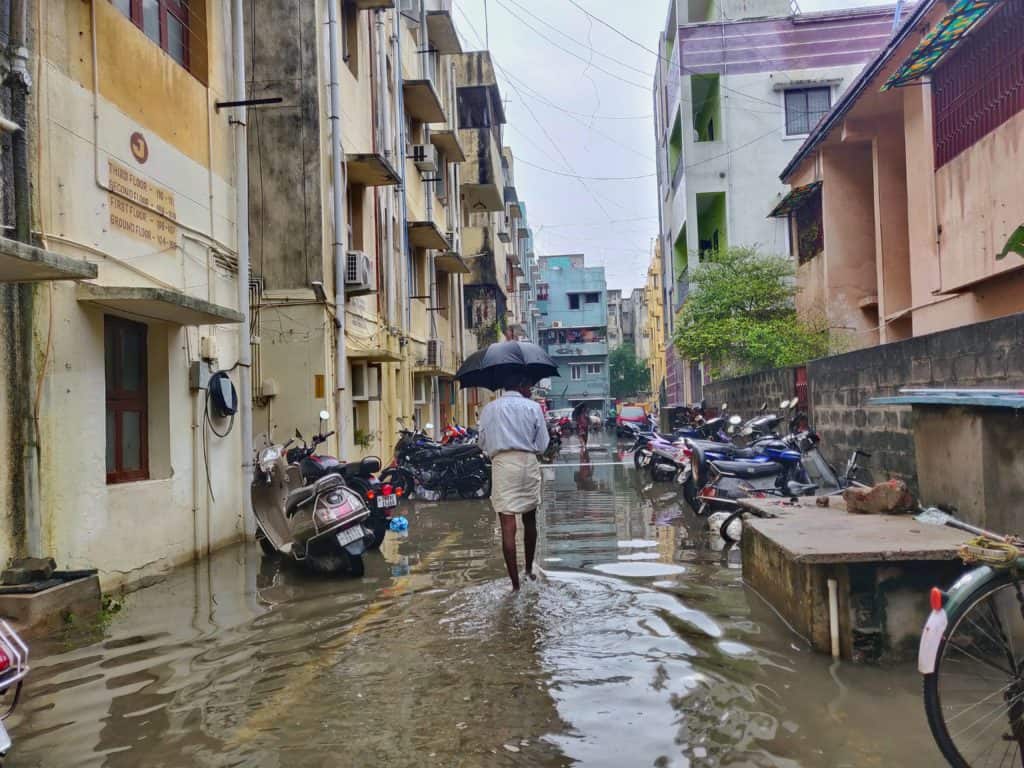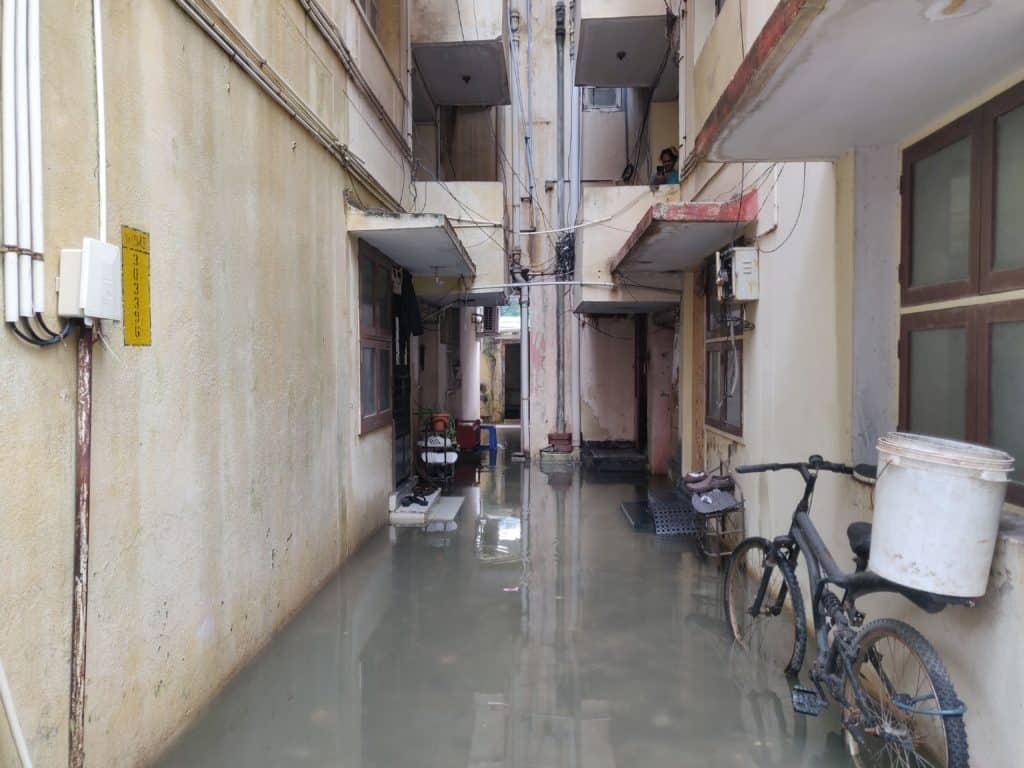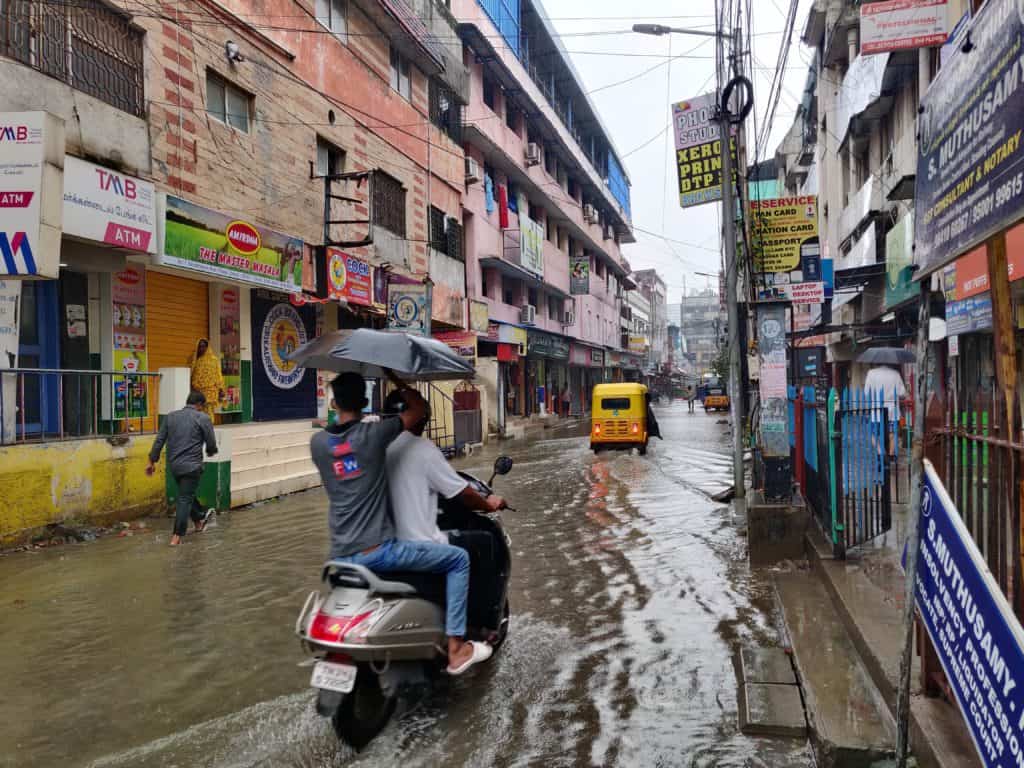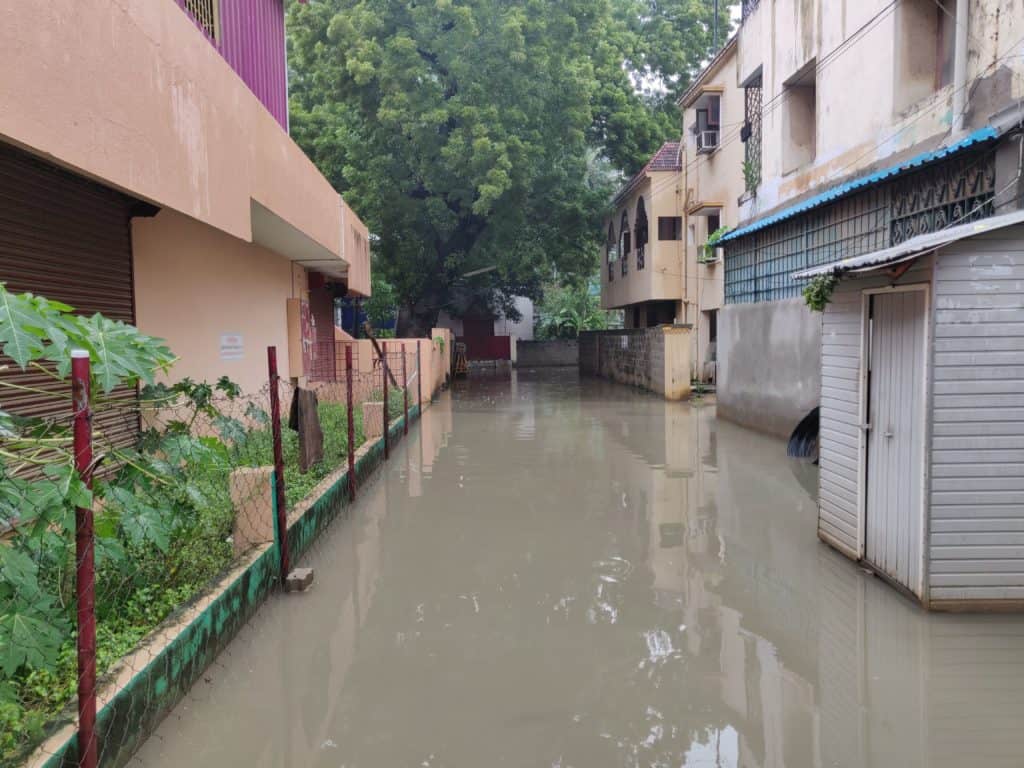It was around 5 am on November 7th, Sunday, when VS Jayaraman was woken up by his brother, who stayed in the ground floor of their apartment. There was considerable commotion at their apartment complex during the early hours of that day. Water had entered all the flats in the ground floor of the building, which is located on Motilal street in T Nagar, as a result of the heavy rains and the subsequent flooding in Chennai through the night of November 6th and the early hours of November 7th.
“We immediately notified the Corporation officials as well as the R1 Mambalam police station. My 96-year-old mother was staying on the ground floor at my brother’s house, where water had entered, so we shifted her to my house on the first floor with the help of police and officials from the MLA’s office**,” says Jayaraman, who is also the president of the T Nagar Residents Welfare Association. The corporation officials advised the residents to turn off power to avoid electrocution. As a result, the families had to go without electricity for the next couple of days, till the water was pumped out of their homes.
This was the case with several other houses and apartment complexes in T Nagar. Bashyam Road, Pondy Bazaar, GN Chetty Road and smaller streets such as Bazullah street, Habibullah Street, Giri road, Usman Road, Ranganathan Street and Rameswaram Street all saw severe inundation as a result of the heavy rains that wreaked havoc across Tamil Nadu’s state capital for almost four days starting November 7th.
Simmering anger
“If the administration is not able to provide bare minimum infrastructure, why should they collect property tax from us?” asks a fuming Jayaraman. There was simmering displeasure among the residents and families of various localities in T Nagar against the authorities and rightfully so, as most of them claim that they have been enduring the issue of flooding and water logging in their area for the past 6 to 7 years.
The missing infrastructure which Jayaraman refers to efficient sewer lines and functional storm water drains. He has been living in T Nagar for over 30 years and says that every time Chennai receives heavy rainfall, the locality gets inundated. “The Residents Association also ends up spending huge amounts of money to clean the open well in their apartment complex, which was constructed by the RWA, because dirty water flows into the well, polluting it,” says Jayaraman. There have been instances where over a lakh was spent during a year by the RWA to clean the well.
Read more: Here’s why we should look at reviving open wells in Chennai this summer
Reasons for water logging
Looking at the realities in the area and speaking to residents, one gets a more or less clear idea of the main factors that lead to T Nagar’s never-ending woes during the rains:
- Blocked underground drains and faulty storm water drains
Sumathi, a resident of Rameswaram road in T Nagar, said that the officials of Chennai Corporation do not engage in proper desilting of storm water drains. “For example, in a street, if there are three storm water drains, the Corporation officials simply open the lid of the drains and clean that particular area. There is no mechanism to clean the stretch between two drains, so it’s usually clogged preventing movement of water,” says Sumathi.
Apart from this, a lot also depends on the amount of rainfall received, the elevation of the area where the storm water drains are constructed and the capacity of the drain. Speaking to us, an engineer from the GCC, who wished not to be named, said that these drains are usually designed to hold between 5 cm to 7 cm of hourly rainfall. However, this time around Chennai received 46 cm of rainfall, which is nearly 5 to 6 times more than the normal.
Also, T Nagar is largely a commercial area and more often than not wrappers, papers, cardboard materials and so on are disposed of into the drains. As a result, the drains get blocked, preventing the movement of water, thus leading to waterlogging. In most drains, huge amounts of plastic, especially discarded polythene bags were found to be choking the drains.
- Blockage in Mambalam canal
One of the biggest shocks was the waterlogging of areas near the Mambalam canal, where restoration work has been taking place for the last couple of years as part of the smart city project. This work includes the construction of an overhead covering for the canal, in order to prevent the dumping of garbage into it, as well as other beautification work like pedestrian pathways, cycle tracks and parks around it.
It was only on the fourth day of the intense rains, i.e Wednesday, November 10th that the officials managed to identify clogging of the canal as one of the reasons for water logging in T Nagar area. The canal, nearly 6-km long, starts near Valluvar Kottam and flows into the Adyar river.
J Karunanithi, DMK MLA from T Nagar constituency said that it was only after they went from street to street, trying to identify the source of water logging in areas near West Mambalam, that they found the blockage of water in the canal on the stretch between Valluvar Kottam and GN Chetty road, due to the presence of debris from the Smart City restoration work.
- Higher level of the road surface
One of the common complaints raised by the residents was the height of the road surface; this being higher than that of the ground on which the houses or apartments stand naturally leads to flooding in the immediate premises of the buildings.
“Earlier, the road levels were nearly a couple of feet below the adjacent housing surface. Now, over a period of time, due to constant relaying of roads, the road levels have risen and thus the ground level of the residential apartments has become lower than the road level. So automatically, when it rains, the water flows into the premises of these apartments and houses, and they get inundated,” says Giresh, who owns a commercial establishment in T Nagar.
Amidst all this chaos, the predominant question being asked by the residents, as well as by the press and social media, is what happened with all the money invested by the Smart City Mission to make T Nagar flood-resilient?
Read more: All is not well at the T Nagar Pedestrian Plaza
City not so smart after all
“Look at our smart city,” says Chandra Bose with a sad smile, as he points to the waterlogged road right in front of the medical shop he runs in Rameswaram street. The entire stretch of road, connecting Rameswaram street, Ranganathan street and further to the Mambalam railway station in T Nagar was inundated, when Citizen Matters did a recce in that area on November 10th, three days after the heavy rains began in the city.
In 2018, the Greater Chennai Corporation (GCC), under the Union Government’s Smart City Mission, invested Rs 200 crore in developing the storm water drains and for the improvement of the Mambalam canal, which passes through T Nagar, in an attempt to make the locality “flood-resilient”.
“Out of the 200 crore, Rs 120 crore was spent on the construction and renovation of existing storm water drains and Rs 80 crore was spent on the Mambalam canal,” says MLA Karunanithi.
“I doubt if they have really spent that much money because if they did, the intensity of the inundation would have been a little less at least right?” asks Jayaraman, who, like many others, feels that the whole idea of a smart city is a farce.
Speaking to media persons after visiting the water logged areas in T Nagar, Chief Minister MK Stalin stated on November 10th that the residents were suffering due to the irregularities in the Smart City Mission and that the previous AIADMK government didn’t implement the project properly as they “took commission” and “committed scams”.
When we called an official from the Chennai Smart City Limited, he refused to comment on the whole issue. Official data on the budget spent on the various projects was also not available.
Way forward
According to the GCC engineer we spoke to, one of the things to be noted is the necessary increase in the width of the Mambalam canal near the Satyamurthy Higher Secondary School for the smooth flow of catchment water into GN Chetty road.
Secondly, he also feels that the Smart City Mission should reconsider going ahead with their plans of setting up a cycle track and walking path near the canal. “As it is, the size of the canal is not adequate to drain the water immediately. Now they want to reduce the width of the canal,” he adds. The engineer says that they plan on setting up a high power commission to decide on a complete redesign of the area.
MLA Karunanithi says that in his first speech as an MLA in the assembly, he had quoted the need for an expanded drain water system across the T Nagar constituency. “Even though the previous government had spent Rs 200 crore on the storm water system, it has not improved the capacity. Now, due to urbanisation, the number of homes in the area has also increased but the smart city projects never took the increase in number of houses under consideration. All they did was to remove old concrete and put new concrete, which is not a solution,” he said.
Meanwhile, Jayaraman feels that the TN government must terminate the smart city work in T Nagar as it has only induced further flooding. “What is the point in beautifying a city which does not have a proper drainage system and storm water drains?” he asks.
** Errata: This quote has been slightly changed from the one in the first published version, following a clarification from the resident quoted.




Ultimately it is the water flow path which can cause flooding. It is imperative all drains are kept debris and silt free
What is spent for post flood manage should be spent for water pathways totally flow friendly. If the exercise of cleaning drains take place regularly in efficient manner before onset of monsoon much agony can be prevented
But here is the catch. Civil works are most prone to cheating by contractors to garner money in collusion with officials. Even third party inspection of works during and after completion are known to have failed. Citizens supervision can be a solution to some extent.
Illegal constructions and wilful deviations main reasons for the stagnsted wster in thee streets all over city. Chennai becomes concreate jungle not SINGARA Chennai. Corrupt babus and netas.